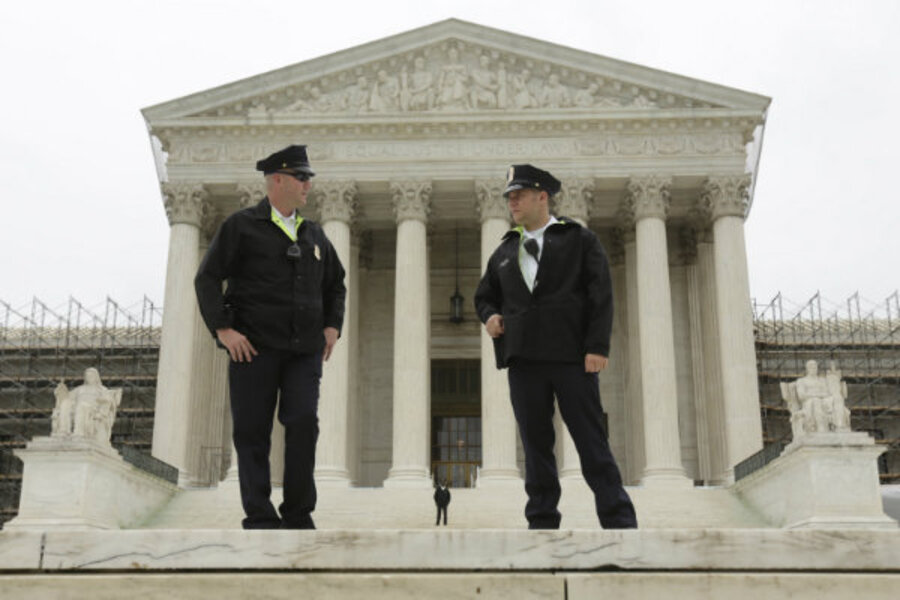Supreme Court: After health care ruling, court must rule against affirmative action
Loading...
| Falls Church, Va. and Sacramento, Calif.
The US Supreme Court will soon decide one of the most consequential cases in years – the challenge to the new federal health care law, often known as Obamacare.
But right behind it comes another blockbuster case.
Next term the court will hear Fisher v. University of Texas at Austin. Health is still the issue – but this time, it’s the health of our multiracial society. Will the public sector – and public universities in particular – finally move beyond a fixation with race, and start treating all people as individuals, not color-coded statistics?
At UT-Austin, admissions directors favor the race-based spreadsheet approach. Race is a criterion in undergraduate admissions – with favoritism for African-Americans and Hispanics – in an effort to achieve a pre-determined mix, or “diversity.” Abigail Fisher, a white female, was denied admission, and she’s suing because she was not evaluated on an equal basis with applicants from other backgrounds.
The court was correct to take this case. It needs to clarify, once and for all, whether the need for “diversity” justifies universities treating individuals differently because of their race.
When the court last considered this issue, in a pair of University of Michigan cases in 2003, it struck down racial preferences in one case but narrowly upheld them in the other. In the latter, Justice Sandra Day O’Connor warned, “We expect that 25 years from now, the use of racial preferences will no longer be necessary...”
So the court was – rather oddly, to be sure – announcing only a temporary waiver of students’ right not to be discriminated against on the basis of skin color and what country their ancestors came from. Since a third of the time allowed for in Justice O’Connor’s projection has passed, it makes sense for the court to revisit the matter.
Studies provide ample evidence that universities are not weaning themselves away from this discrimination. To the contrary: A study last fall of the University of Wisconsin by the Center for Equal Opportunity found the most pronounced undergraduate admissions discrimination the center had ever seen. Recent studies show that law school discrimination at UW and elsewhere is severe, too. Studies of medical school admissions have reached the same conclusion.
At one time, affirmative action was designed to benefit African Americans recently subjected to Jim Crow, over whites who had been the segregated system’s beneficiaries. But now, more and more, it is Asians (our fastest growing ethnic group) who are discriminated against in favor of Latinos (our largest minority). At the University of Texas, for instance, in 2009, admitted Asians had an average SAT score 197 points higher than the average score for admitted Hispanics.
What’s the historical justification for that difference?
As for the “diversity” rationale, it is becoming more and more problematic to justify using race and ethnicity as a proxy for people’s perspectives and experiences – or to identify students from disadvantaged backgrounds. There are of course many white and Asian students who come from disadvantaged backgrounds, and many African Americans and Latinos who do not.
In fact, a frequently cited pro-racial preference book – “The Shape of the River” by William G. Bowen and Derek Bok – acknowledged that 86 percent of the African American students admitted to the schools it surveyed (selective colleges and universities using affirmative action) had “middle” or “high” socioeconomic status. Only 14 percent came from “low” socioeconomic backgrounds.
Even if there are some marginal educational benefits for students from greater “diversity,” they are few and thin compared to the substantial costs – costs, that is, from institutionalizing racial discrimination that must be borne by society as a whole, the universities, and the students themselves.
For example, empirical evidence has come to light that among the victims of admission preferences for blacks and Latinos are...blacks and Latinos. That is, by mismatching students and institutions, students are set up for failure. A study by UCLA Law School Professor Richard Sander found there would be more African Americans in the legal profession if affirmative action weren’t routing students to schools that aren’t a good academic fit – and from which, too often, they don’t graduate.
The use of racial preferences is simply wrong, for a host of reasons, including: It is personally unfair; it can stigmatize the so-called beneficiaries in the eyes of their classmates, teachers, and themselves, as well as future employers, clients, and patients; it compromises the academic mission of the university; and it gets states and schools involved in unsavory activities like deciding which racial and ethnic minorities will be favored and how to establish group membership.
One constant is that racial preferences remain very unpopular. A recent Rasmussen poll found 55 percent of Americans saying they were against “affirmative action” in college admissions, with only 24 percent for, and 21 percent undecided. If the question had been about “racial preferences” – a less ambiguous term – presumably the survey would have shown even greater unpopularity.
The face of America is changing, and it is untenable to be sorting Americans by skin color in a nation that is becoming more and more multiracial and multiethnic.
The justifications for such discrimination have grown weaker, and the costs more apparent. And many Americans, to their credit, are fed up with it. The Supreme Court should rule in favor of Abigail Fisher and tell universities that they must stop judging applicants by the color of their skin and their national origin: The nation’s long-term health demands it.
Roger Clegg is president and general counsel of the Center for Equal Opportunity, and Joshua Thompson is an attorney with Pacific Legal Foundation. In the Fisher case, the Pacific Legal Foundation has filed an amicus brief, which the Center for Equal Opportunity joined, urging the Supreme Court to outlaw race-based preferences and discrimination in university admissions.





